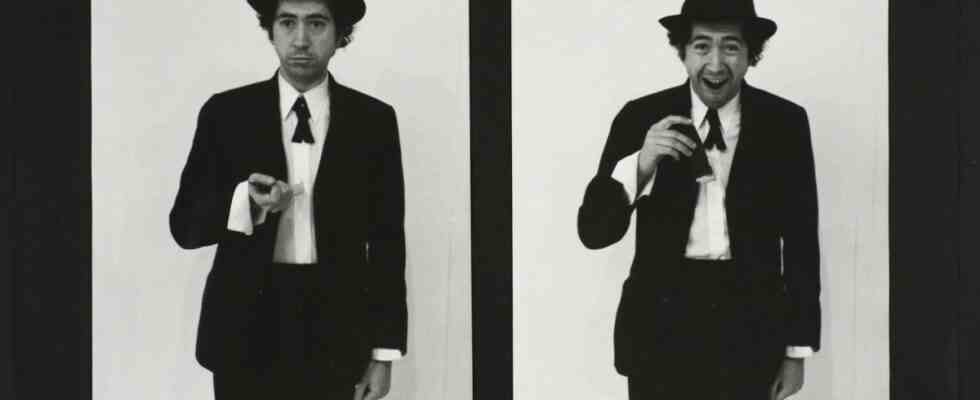“The Hanging” from the series “Tode zum Lachen” by Christian Boltanski in the Valentin-Karlstadt-Musäum.
(Photo: Munich City Museum; Valentin-Karlstadt-Musäum)
“The Drowning” from the series “Tode zum Lachen” by Christian Boltanski in the Valentin-Karlstadt-Musäum.
(Photo: Munich City Museum; Valentin-Karlstadt-Musäum)
A film evening in Paris in the early 1970s was to change his work abruptly for a certain period of time. The French conceptual artist Christian Boltanski, known as the “forerunner”, visited a Karl Valentin retrospective at the Goethe-Institut together with his friend, the German art historian Günter Metken. The films of the Munich comedian impressed Boltanski so much that he dedicated himself to a radically different art for about two years: comedy, the absurd, the clownesque. Or as he later wrote: “The consequence was that I wanted to destroy my own style… I’m not who you think you know… and I’ll prove it to you by turning it clownish. ” This commitment can be read in the catalog for the exhibition “Christian Boltanski – Tode zum Lachen”, which opened on Thursday in Munich’s Valentin Karlstadt Museum on the first anniversary of the artist’s death, who died last year at the age of 76.
Christian Boltanski created the “Petit Christian” doll as an alter ego.
(Photo: Valentin Karlstadt Museum)
Films, photographs, stage sets, props, posters and poster drafts, personal items, records and the drafts for the covers, leaflets, invitation cards and the child-sized doll “Petit Christian” (Boltanski’s alter ego) with which he acts in the films – around 180 exhibits can be seen here. Above all, however, a self-promoter can be experienced who laughs the most at himself – for example, when he demonstrates the various types of suicide, those “deaths for laughing”: hanging, drowning, stabbing, poisoning, shooting. It’s also wonderful when it depicts supposed childhood memories with grandfather, mother and father. Everything sparkles with absurd comedy, through which a lot of profound sadness shimmers again and again.
The exhibition was curated by Sabine Rinberger, Director of the Valentin Karlstadt Museum. And she not only exhibited the pictures, films and objects, but also tried to show the intellectual connection between Valentin and Boltanski with the help of quotes from Valentin. Probably the most important thing, which also gave the exhibition its title: “You know, I can’t be any funnier, but I don’t want people to die laughing!”
Boltanski’s life was marked by the memory of the Holocaust
Death was always present in Christian Boltanski’s work, and his life was shaped by the memory of the Holocaust. The Jewish father had survived two years in Nazi-occupied Paris in a hiding place in the attic of his own apartment. A trauma that weighed on the whole family for life, as was later discovered through the book “The Hiding Place” by Boltanski’s nephew Christoph. When Christian was born on September 6, 1944, the liberation was being celebrated in Paris. So his parents gave him “Liberté” as his middle name.
With his expansive installations, as well as collections and archives of the deceased, Christian Boltanski fought against oblivion in his main work. Because of these works, he took part in several Documenta exhibitions in Kassel, was invited to design the French pavilion at the Venice Biennale in 2011, and received numerous important awards in France, Germany and Japan. In Munich, his work was shown in 1997 parallel to the design of Edition No. 46 of the SZ-Magazine with “Lost in Munich” in the Haus der Kunst. In 2017, current video works from the “Animitas” series, deeply sad in content but optically enchantingly poetic, could be seen at Espace Louis Vuitton.
Boltanski poster “The Frenzied”.
(Photo: Valentin Karlstadt Museum)
Boltanski poster “The Joker”.
(Photo: Valentin Karlstadt Museum)
The comic early work inspired by Valentin from the years 1974 – 75 remained a solitaire. But large parts of this could also be seen in Munich, in April 1993. After the exhibition, Boltanski donated all the exhibits – above all the “Petit Christian” doll – to the Valentin-Karlstadt-Musäum and made a funny number out of it himself: Die historically designed donation certificate hangs right at the entrance to the exhibition. In it he describes himself “as a long-time friend of Karl Valentin and at the same time as a student of this master”. The document not only bears Boltanski’s signature, but is also marked: “Estimated value: 250,000 DM”. Grotesque of fate: The works of the French conceptual artist Christian Boltanski, which are based on archives of the deceased, are likely to have become much more expensive after his death. Also the clownesque early work. A municipal institution like the Valentin-Karlstadt-Musäum could never have afforded an archive of this deceased.
Christian Boltanski – Death to Laugh, Valentin Karlstadt Museum in the Isartor, Tal 50, until November 15th

